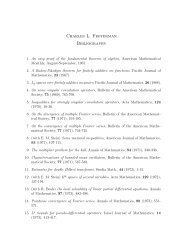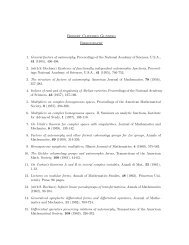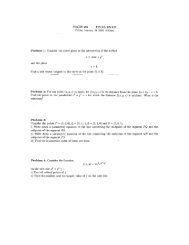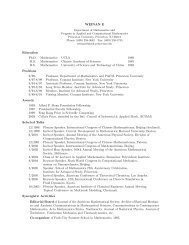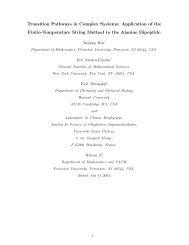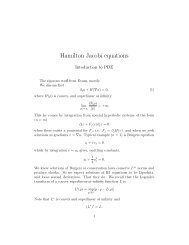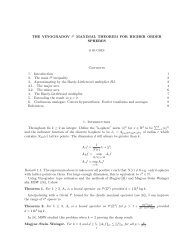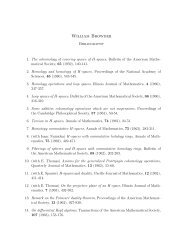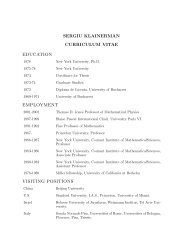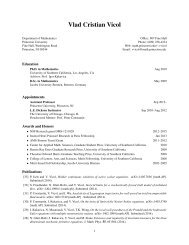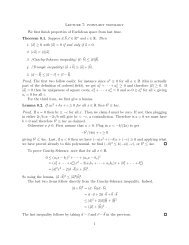The rational Khovanov homology of 3-strand pretzel links
The rational Khovanov homology of 3-strand pretzel links
The rational Khovanov homology of 3-strand pretzel links
Create successful ePaper yourself
Turn your PDF publications into a flip-book with our unique Google optimized e-Paper software.
skein sequence is<br />
f<br />
THE RATIONAL KHOVANOV HOMOLOGY OF 3-STRAND PRETZEL LINKS 25<br />
q −1 Kh(−T n−l,2 ) Kh(P(−l,m,n)) q 3l−3n−2 t l−n−1 Kh(P(−l,m − 1,n))<br />
Again, call the left-hand term W, the middle term X, and the right-hand term V .<br />
W has exceptional pairs in t = l − n and t = 0, while V has an exceptional pair in<br />
t = l − n − 1. X has an exceptional pair in t = 0. Write V = L ⊕ U. By induction,<br />
and the grading shifts in the sequence, L is based at (−m − n, −2m − 2n − 1) and U is<br />
based at (2l − m − n + 1, 4l − 2m − 2n − 1). <strong>The</strong>se values agree with the RR row <strong>of</strong><br />
Table 1.<br />
<strong>The</strong> analysis <strong>of</strong> the cancellations proceeds as above. <strong>The</strong> lowest t-grading in W is<br />
t = l−n, where it has an exceptional pair, and V has its exceptional pair in t = l−n−1.<br />
Lemma 3.8 ensures a standard cancellation occurs between t = l − n and t = l − n − 1.<br />
Afterwards, Remark 3.7 and Lemma 3.6 apply, and no more cancellations can occur (in<br />
particular, no cancellation occurs in the highest t-grading). Easy checks now verify our<br />
formulas, as before.<br />
□<br />
4.3. P(−l,l + 1,n) for odd l and general n. Now we will compute Kh(P(−l,l +<br />
1,n)) LL for even n, given that we know our formula holds for odd n.<br />
Lemma 4.4. For n ≥ l + 1, Kh(P(−l,l + 1,n) LL ) is given by the formula in <strong>The</strong>orem<br />
2.9.<br />
Pro<strong>of</strong>. We have already proved the result for odd n > l + 1 in <strong>The</strong>orem 4.3. Hence,<br />
we may assume n is even. Resolve the top crossing on the rightmost <strong>strand</strong>, a positive<br />
crossing. Our diagram for P(−l,l + 1,n) LL has 2l + 1 negative crossings, while the<br />
unoriented resolution (a diagram for the unknot) has l + n − 1 negative crossings.<br />
Hence ǫ = n − l − 2. <strong>The</strong> oriented resolution is a diagram for P(−l,l + 1,n − 1). <strong>The</strong><br />
skein sequence is<br />
f<br />
q 3n−3l−4 t n−l−1 Kh(U) Kh(P(−l,l + 1,n)) qKh(P(−l,l + 1,n − 1))<br />
where U is the unknot, with <strong>Khovanov</strong> polynomial q + q −1 . Denote the left, middle,<br />
and right terms by W, X, and V respectively. V has an exceptional pair in t = 0 and<br />
W has an exceptional pair in t = n − l − 1. X has exceptional pairs in both t = 0 and<br />
t = n − l − 1 by Proposition 2.13, since the linking number <strong>of</strong> the two components <strong>of</strong><br />
P(−l,l + 1,n) LL is n−l−1 .<br />
2<br />
Suppose n > l + 1, and write V = L ⊕ U. It is clear that L and U are based at<br />
the right points to form the lower and upper summands for Kh(P(−l,l + 1,n) LL ), by<br />
looking at Table 1 and the grading shift <strong>of</strong> q in the above sequence. <strong>The</strong> situation is<br />
shown in Figure 11. <strong>The</strong>re is no cancellation since V ∗,n−l−1 = 0, dimW ∗,n−l−1 = 2, and<br />
X has an exceptional pair in t = n − l − 1.<br />
If n = l + 1, then V comes from the <strong>Khovanov</strong> <strong>homology</strong> <strong>of</strong> P(−l,l + 1,l), which was<br />
not covered in <strong>The</strong>orem 4.3. However, P(−l,l+1,l) = P(−l,l,l+1), and we computed<br />
f<br />
f<br />
,<br />
.




